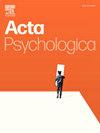Empirical exploration of the 4P theory of creativity using virtual reality
IF 2.7
4区 心理学
Q2 PSYCHOLOGY, EXPERIMENTAL
引用次数: 0
Abstract
In the 4P theory of creativity, Rhodes in 1961 emphasises the importance of different components in human creativity, which arises from the dynamic interplay of four key components: Person, Process, Product, and Press. Following previous studies that focused on relations among the 4P components, we conducted an exploratory empirical study with a sample of 60 participants using virtual reality. In our study we investigated: Person through self-report questionnaires on participants' personality and creativity traits; Process through the registrations of users' interactions during a VR task in which they create artworks; Product through a semi-automated ontological analysis of the artworks' features; Press by altering the virtual environment with contextual auditory stimuli.
Our research contributes to the study of creativity, using Virtual Reality as a platform for an empirical investigation of the relations between the 4P components of creativity. Our findings suggest an intricate network of components, with significant correlations for 5 out of 6 relations. Our findings are in line with previous research about the relation between Person and Process, between Person and Press, and between Process and Product, and show novel insights about the relation between Person and Product and between Press and Process.
We have applied our novel method to the original 4P foundational domains, demonstrating its utility to lay a research ground to formally (via ontological distinctions) and empirically (based on explicit and implicit measures) compare creativity theories that extend 4P components, possibly addressing cognitive abilities, expertise and impact levels, error functionalization, creativity dynamics, etc.
利用虚拟现实对创造力4P理论的实证探索
在创造力的4P理论中,Rhodes在1961年强调了人类创造力中不同组成部分的重要性,这源于四个关键组成部分的动态相互作用:人、过程、产品和压力。继以往的研究侧重于4P要素之间的关系,我们进行了一个探索性的实证研究与60个参与者使用虚拟现实的样本。在本研究中,我们调查了:人通过自我报告问卷对被试的人格特征和创造力特征进行了调查;在用户创建艺术品的VR任务中,通过注册用户的交互过程;产品通过半自动化的本体分析艺术品的特征;通过情境听觉刺激改变虚拟环境来按压。我们的研究有助于创造力的研究,利用虚拟现实作为一个平台,对创造力的4P组成部分之间的关系进行实证调查。我们的发现表明了一个复杂的组件网络,在6个关系中有5个具有显著的相关性。我们的发现与之前关于人与过程、人与媒体、过程与产品之间关系的研究一致,并对人与产品、媒体与过程之间的关系提出了新的见解。我们将我们的新方法应用于最初的4P基础领域,展示了它的实用性,为正式(通过本体论区别)和经验(基于显式和隐式测量)比较扩展4P组件的创造力理论奠定了研究基础,可能涉及认知能力、专业知识和影响水平、错误功能化、创造力动态等。
本文章由计算机程序翻译,如有差异,请以英文原文为准。
求助全文
约1分钟内获得全文
求助全文
来源期刊

Acta Psychologica
PSYCHOLOGY, EXPERIMENTAL-
CiteScore
3.00
自引率
5.60%
发文量
274
审稿时长
36 weeks
期刊介绍:
Acta Psychologica publishes original articles and extended reviews on selected books in any area of experimental psychology. The focus of the Journal is on empirical studies and evaluative review articles that increase the theoretical understanding of human capabilities.
 求助内容:
求助内容: 应助结果提醒方式:
应助结果提醒方式:


